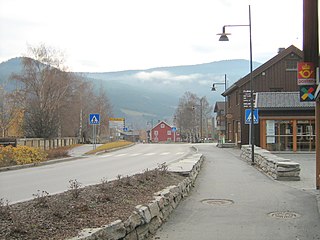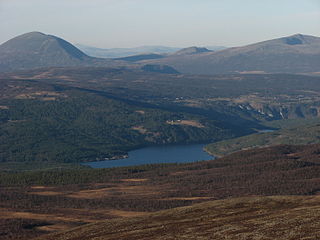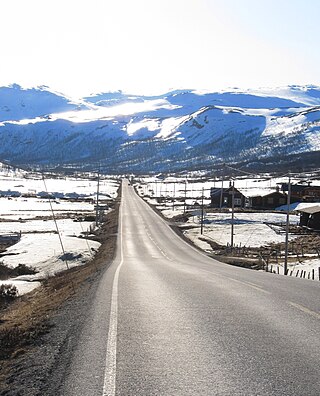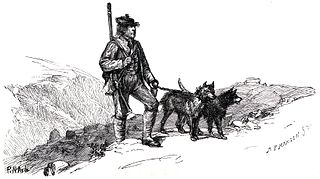
Sigrid Undset was a Danish-born Norwegian novelist. She was awarded the Nobel Prize for Literature in 1928.

Folldal is a municipality in Innlandet county, Norway. It is located in the traditional district of Østerdalen. The administrative centre of the municipality is the village of Folldal. The municipality was established in 1914 when it was separated from Alvdal Municipality.

Dovre is a municipality in Innlandet county, Norway. It is located in the traditional district of Gudbrandsdal. The administrative centre of the municipality is the village of Dovre. Other villages in Dovre include Dombås and Hjerkinn. The municipality is bordered on the north by Oppdal municipality, on the east by Folldal, on the south by Sel and Vågå, and on the northwest by Lesja. The highest peak in the municipality is Snøhetta at a height of 2,286 metres (7,500 ft).

Vågå is a municipality in Innlandet county, Norway. It is located in the traditional district of Gudbrandsdal. The administrative centre of the municipality is the village of Vågåmo. Other village areas in Vågå include Lalm and Bessheim.

Nord-Fron is a municipality in Innlandet county, Norway. It is located in the traditional district of Gudbrandsdal. The administrative centre of the municipality is the town of Vinstra. Other population centers in Nord-Fron include the villages of Kvam and Skåbu.

Sel is a municipality in Innlandet county, Norway. It is located in the traditional district of Gudbrandsdal. The administrative centre of the municipality is the town of Otta. The municipality also includes several notable villages including Bjølstad, Dale, Høvringen, Nord-Sel, Sandbumoen, Sjoa, and Skogbygda.

Skaun is a municipality in Trøndelag county, Norway. It is part of the Orkdalen region. The administrative centre of the municipality is the village of Børsa. Other villages include Buvika, Eggkleiva, Melby, Skaun, and Viggja.

Rondane National Park is the oldest national park in Norway, established on 21 December 1962. The park is located in Innlandet county, in the municipalities of Dovre, Folldal, Sel, Nord-Fron, Sør-Fron, Stor-Elvdal, and Ringebu. The park contains ten peaks above 2,000 metres (6,560 ft), with the highest being Rondeslottet at an altitude of 2,178 m (7,146 ft). The park is an important habitat for herds of wild reindeer.

Gudbrandsdalen is a valley and traditional district in the Norwegian county of Innlandet. The valley is oriented in a north-westerly direction from Lillehammer and the lake of Mjøsa, extending 230 kilometers (140 mi) toward the Romsdalen valley. The river Gudbrandsdalslågen (Lågen) flows through the valley, starting from the lake Lesjaskogsvatnet and ending at the lake Mjøsa. The Otta river which flows through Otta valley is a major tributary to the main river Lågen. The valleys of the tributary rivers such as Otta and Gausa (Gausdal) are usually regarded as part of Gudbrandsdalen. The total area of the valley is calculated from the areas of the related municipalities. Gudbrandsdalen is the main valley in a web of smaller valleys. On the western side there are long adjacent valleys: Ottadalen stretches 100 kilometers (62 mi) from Otta village, Gausdal some 50 kilometers (31 mi) from Lillehammer and Heidal some 40 kilometers (25 mi) from Sjoa. Gudbrandsdalen runs between the major mountain ranges of Norway including Jotunheimen and Dovrefjell–Rondane.

is a town in Sel Municipality in Innlandet county, Norway. The town is also the administrative centre of the municipality. The town is located at the confluence of the Gudbrandsdalslågen and Otta rivers. The European route E6 highway runs through the town. The Dovrebanen railway line also passes through the town, stopping at the Otta Station. The 2.13-square-kilometre (530-acre) town has a population (2021) of 2,283 and a population density of 1,073 inhabitants per square kilometre (2,780/sq mi).

The culture of Norway is closely linked to the country's history and geography. The unique Norwegian farm culture, sustained to this day, has resulted not only from scarce resources and a harsh climate but also from ancient property laws. In the 19th century, it brought about a strong romantic nationalistic movement, which is still visible in the Norwegian language and media. In the 19th century, Norwegian culture blossomed as efforts continued to achieve an independent identity in the areas of literature, art and music. This continues today in the performing arts and as a result of government support for exhibitions, cultural projects and artwork.
Tiina Nunnally is an American author and translator.

Filefjell is a mountainous area in Norway. It is located between Lærdal in the Vestland county and Valdres in Innlandet county. It is the historical, as well as modern, main route, linking Western Norway and Eastern Norway. The European route E16 highway passes through Filefjell.

Vinstra is a town in Nord-Fron Municipality in Innlandet county, Norway. The town is the administrative centre of the municipality. The town is located in the Gudbrandsdalen valley, at the confluence of the Gudbrandsdalslågen river and the Vinstra river. The 3.07-square-kilometre (760-acre) town has a population (2021) of 2,678 and a population density of 872 inhabitants per square kilometre (2,260/sq mi).

Kristin Lavransdatter is a trilogy of historical novels written by Sigrid Undset. The individual novels are Kransen, first published in 1920, Husfrue, published in 1921, and Korset, published in 1922. Kransen and Husfrue were translated from the original Norwegian as The Bridal Wreath and The Mistress of Husaby, respectively, in the first English translation by Charles Archer and J. S. Scott.

Rondvatnet is a lake in Sel Municipality in Innlandet county, Norway. The 95.58-hectare (236.2-acre) lake is a long, narrow lake in Rondane National Park, about 20 kilometres (12 mi) northeast of the town of Otta. The Norwegian Mountain Touring Association's tourist cabins at Rondvassbu are located at the southern end of this lake. Rondvatnet separates the eastern part of Rondane from the western part which is the site of Smiubelgen.
Nonneseter Abbey, Oslo, was a Benedictine convent located in Oslo, Norway, active between the 12th and 16th centuries.
The Bøyg, also referred to as the "Great Bøyg of Etnedal" is a legendary gnome-like creature in Scandinavian folklore.

Per Gynt is a Norwegian fairy-tale which originated in the traditional region of Gudbrandsdal.
Kari Rolfsen was a Norwegian sculptor and illustrator.

















